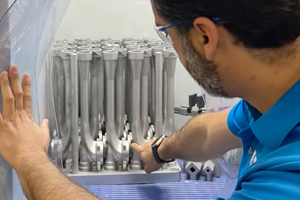Horizon Microtechnologies’ Functional Coatings for Conductive, Durable Parts
Formnext 2023: Horizon Microtechnologies offers functional coatings on 3D printed parts with micrometer-scale precision, enabling the micro-additive manufacturing of conductive and durable parts.
Horizon Microtechnologies has developed a template-based 3D microfabrication technology that gives manufacturers the ability to add conductivity to all or selected parts of a 3D-microfabricated template. Photo Credit: Horizon Microtechnologies
Horizon Microtechnologies’ coating processes for microstructures enhance the functionality of microstructures, predominantly for parts produced via micro-additive manufacturing (AM). By adding nonmetallic conductive, environmentally-resistant and metallic coatings to polymer micro-AM parts and components, Horizon’s coatings open up the advantages of AM to sectors and applications that were previously unable to utilize AM due to a limited palette of materials that micro AM was able to process, which in turn restricted part functionality.
This technology is well suited for previously unserved areas of industry by adding material and functionality to the microstructure, typically with a coating process. “Our company has a unique understanding of the micro-AM based 3D microfabrication process chain. And, while we provide a suite of post-build coating processes, our ability to now build parts in-house on the BMF machine allows us to provide a complete technology infrastructure in-house,” says Andreas Frölich, Horizon CEO. “This means customers can benefit from a truly vertically integrated solution from design to delivery. It also speeds up the development of our post-build coating technologies which will have a profound impact on industry by continually broadening the use of micro-AM into different application areas.”
Horizon says the its vision is to stimulate the use of micro-AM into application areas that were previously unable to take advantage of the technology’s inherent agility and manufacturing efficiency due to material constraints. The company recently purchased BMF’s microArch S240 micro AM machine. The company says it chose to work with Boston Micro Fabrication (BMF) because its micro-AM platforms are suitable for both prototypes and end products, and push the boundaries of resolution, accuracy and precision in AM technology and promote miniaturization with new applications in many industries.
The microArch machines use the process of projection microstereolithography (PµSL), which combines the advantages of digital light processing (DLP) and stereolithography — a flash of light triggers the rapid photopolymerization of an entire layer of resin. Continuous exposures increases the build speed, and components are built up from the top down in a resin basin, which reduces the need for support structures, all of which helps to streamline the micro-AM workflow for Horizon.
Frölich says Horizon offers coating processes that offer versatility, enabling the production of intricate parts using the microArch S240. “Horizon can act as an end-to-end product development and contract manufacturing partner, influencing the design of micro AM parts to optimize them for end-use functionality and also optimize them for the application of our proprietary coating technologies,” Frölich adds. “We can wholly or selectively coat micro-AM parts with a nonmetallic conductive layer, add environmental resistance to parts, enabling the creation of microscale devices that are more durable, reliable and better suited for use in harsh environments — such as in the presence of aggressive chemicals and/or high temperatures, and can wholly or selectively coat micro-AM parts with copper.”
Horizon’s metallic copper coatings are typically in the 1-2 micron thickness range, which is sufficient for many applications. Also, the company’s process can also coat internal channels and undercuts to some degree, with the channel’s aspect ratio being the limiting factor rather than the absolute length. This is a significant advance for copper coating of micro-AM templates, the company says.
- Learn more about Horizon Microtechnologies’ micro additive manufacturing for conductive, environmentally-resistant parts. The company has developed a template-based 3D microfabrication technology that gives manufacturers the ability to add conductivity to all or selected parts of a 3D-microfabricated template.
Related Content
Finland’s Largest Metal 3D Print Withstands Pressure Vessel Test, Vastly Exceeding Expectations
The pressure vessel was created in cooperation between Andritz Savonlinna Works and the Finish Additive Manufacturing Ecosystem (FAME), and withstood the nondestructive and destructive tests carried out by LUT University.
Read MoreAMT’s PostPro Pure Offers Sustainable Vapor Smoothing Chemistry
Formnext 2022: This FDA-approved chemistry offers a green approach for vapor smoothing 3D printed parts.
Read More5 Big Themes in Additive Manufacturing at Formnext Forum: Austin
Formnext Forum: Austin, a two-day event at the end of August focused on additive manufacturing for production, includes a conference exploring important ideas in AM related to supply chains, bridge production, enterprise transformation and more.
Read MoreWhat We Found at Formnext 2023
New metal processes, new possibilities for existing processes, the next step for copper and more. Here is a summary drawing on all our reporting from November’s event.
Read MoreRead Next
3D Printing Brings Sustainability, Accessibility to Glass Manufacturing
Australian startup Maple Glass Printing has developed a process for extruding glass into artwork, lab implements and architectural elements. Along the way, the company has also found more efficient ways of recycling this material.
Read MoreHybrid Additive Manufacturing Machine Tools Continue to Make Gains (Includes Video)
The hybrid machine tool is an idea that continues to advance. Two important developments of recent years expand the possibilities for this platform.
Read More4 Ways the Education and Training Challenge Is Different for Additive Manufacturing
The advance of additive manufacturing means we need more professionals educated in AM technology.
Read More









.png;maxWidth=300;quality=90)














